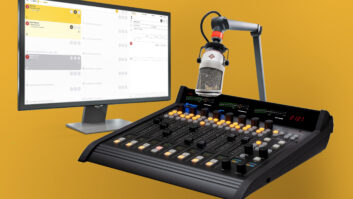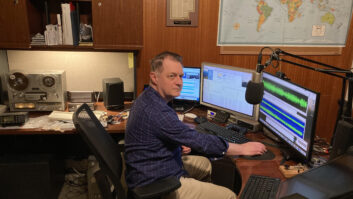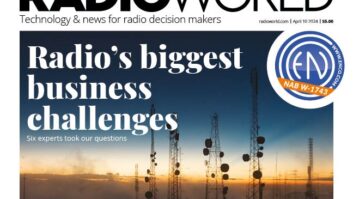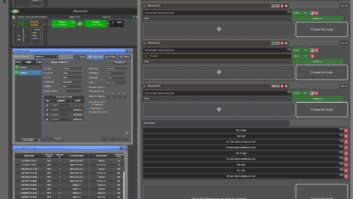
iStockphoto/Pavlo61 For Mark Persons:
Just read your Tech Tips article in the Aug. 13 issue (“Capture the Sporting Spirit, Get in the Game!”) and thought you’d be interested in some of my observations.
I have to agree with you about crowd noise to a point. Not all of it is the sportscaster’s fault though.
Out here in Connecticut, we’re unfortunate enough to be between two huge rival American League baseball teams: the New York Yankees and the Boston Red Sox.
Depending on which marketing person you listen to, some people think Connecticut is a Red Sox state, while others think it’s a Yankees state. I grew up about 50 miles from New York City, so I’m a Yankees fan. Luckily, their games are broadcast on WFAN 660 (50 kW non-D) about 75 miles from me; and this year WELI, a local 5 kW station, carried their games via the Yankees Radio Network, which originates at WFAN.
Out at the ballpark, there are two announcers/sportscasters (John Sterling and Suzyn Waldman) who do play-by-play and other gibber-jabber chit-chat; and an engineer/producer who runs the local board, tells them when to read spots, and sends cue tones over the network to WFAN where they go up to the satellite. The tones trigger station IDs and commercial breaks at the various network member stations, such as WELI here in town. Most of the network stations are automated. This works fine until there’s a rain delay or postponement, then human intervention is needed.
During those commercial breaks, the announcers either stop talking or their mics are turned off. Unfortunately the crowd mic is still alive and kicking.
I’ve noticed several things about the crowd noise:
1. It’s always way too loud at home games at Yankee Stadium; the away games always have much softer crowd noise, and it doesn’t seem to be as obnoxious.
Even the chief engineer of WELI noticed this. He was able to listen to the audio coming right off the satellite receiver and commented that home game crowd noise is much louder than away game crowd noise.
2. The crowd noise is certainly 10–20 dB lower than the announcer’s voices, but during quiet times like when a station ID is playing or there’s a break in the action, there must be several AGC amps doing their best to raise the audio level to 99 percent and the crowd noise just builds and builds and builds over a 15-second period. When the announcers do come back and either touch their mics or utter their first syllable, all those AGCs now have to duck way down to reduce the gain. Some overshoot and eventually recover, but you can hear the ducking and quiet that follow. The crowd noise reaches the same level as the voice at the output of the satellite receiver, so it doesn’t need much help from all the other AGCs.
3. I usually watch the games on YES, the Yankees Entertainment and Sports network channel via DirecTV satellite. I also listen to their audio, and while they too have crowd noise, it doesn’t seem to be affected by AGC nearly as much as it is on the radio network. I have a Dorrough Loudness Meter on the audio output of my satellite receiver, and I can watch the crowd noise sit around –26 dB for 30 seconds while the announcers silently watch the play, and it never get any louder. I can’t do that on the radio.
Unfortunately the TV announcers will talk about everything except the game, so I often turn the sound off and listen to the radio audio. I use the DVR in the satellite receiver to delay the video to sync it with the radio audio and it works great. I get the best of both worlds that way, except for the crowd noise.
4. I can pick up the Yankees Radio Network on several stations besides WFAN and WELI. All of them suffer the same strong AGC action on crowd noise. I definitely get ear-tired listening to the constant 99 percent modulated roar that goes on in home games. For all I know, there’s an AGC at the game feeding the WFAN studio, possibly an AGC coming out of WFAN feeding the satellite transmitter, definitely an AGC in the network station’s automation system switcher, and multiple AGCs and limiters in the network station’s audio chain so it can get to the transmitter. They all work great, except for crowd noise.
I remember back in the ’60s and ’70s when it was cool to essentially “eat the mic” and talk real close to it. It gave the DJ a sense of intimacy with his/her listening audience. Unfortunately, you also got to hear every inhale breath, every P, every S, etc. I still hear that today on some radio stations — but only on some announcers, and it gets really tiring. All they have to do is move the mic out of direct mouth-shot and put it off to the side or even above the mouth, and move it a few inches away.
Yes, everybody has to breathe, but we don’t need to have it exaggerated to the point of being louder than the voice we’re trying to listen to.
Bob Meister
Hamden, Conn.












